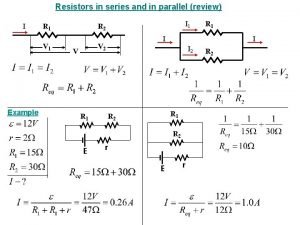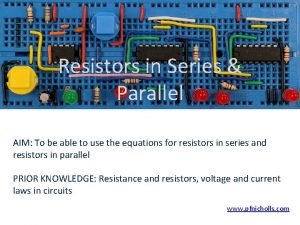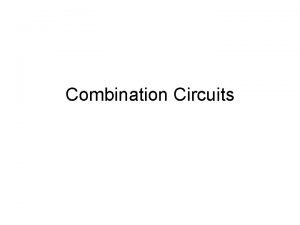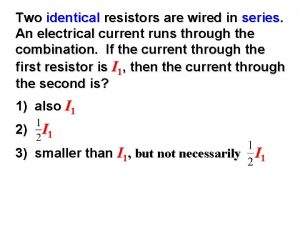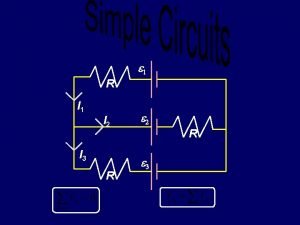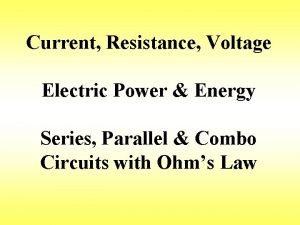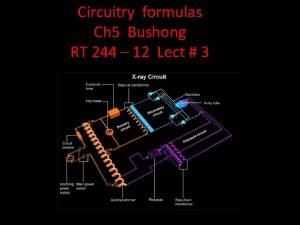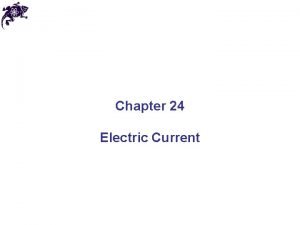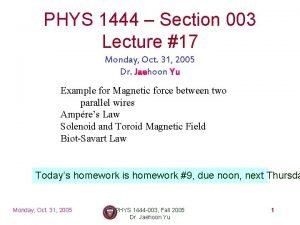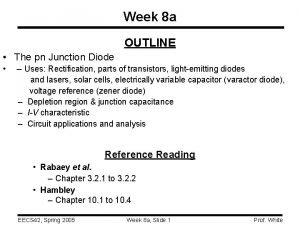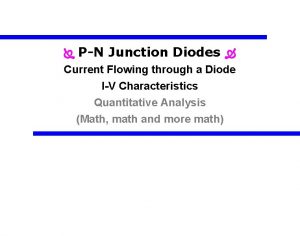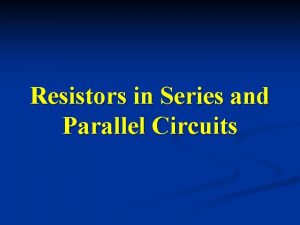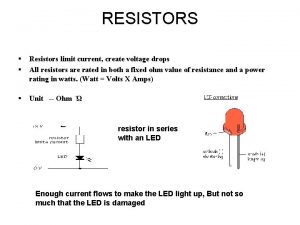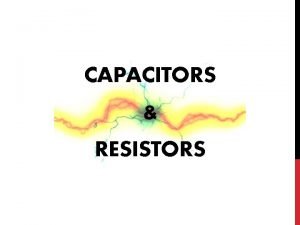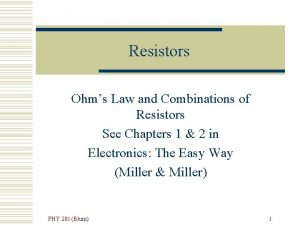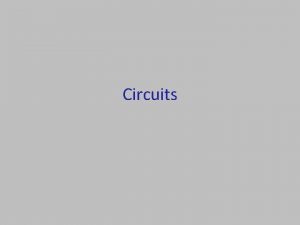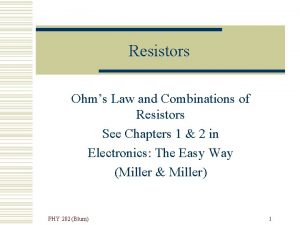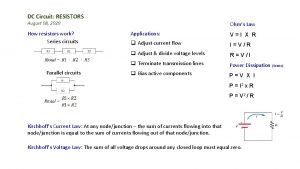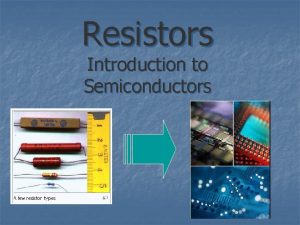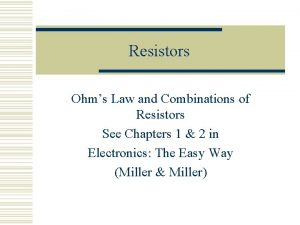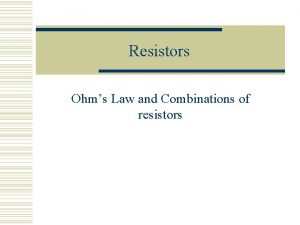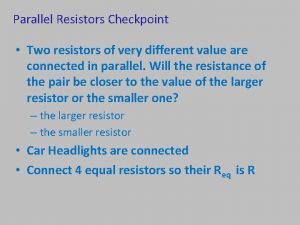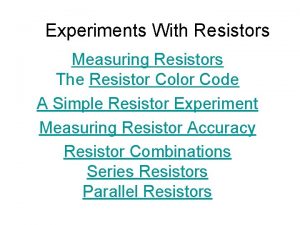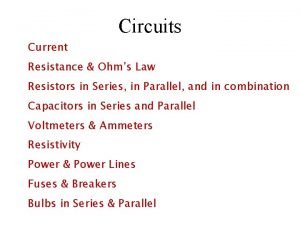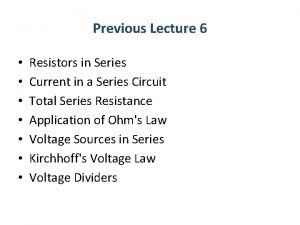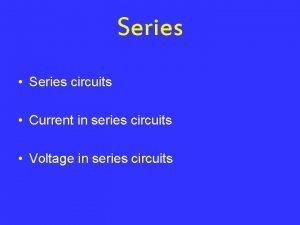This Class Resistors in series Current through is






























- Slides: 30

This Class Resistors in series: Current through is same. Voltage drop across is IRi Resistors in parallel: Voltage drop across is same. Current through is V/Ri Solve Circuits R 2 R 1 V R 3 R 4

Kirchhoff’s First Rule (“Loop Rule” or “Kirchhoff’s Voltage Law”) The algebraic sum of the changes in potential encountered in a complete traversal of any loop of circuit must be zero. e 1 e I R 1 R 2 Move around circuit: 9/15/2020 2

e 1 Rules e I R 1 R 2 Voltage Gains enter with a + sign. Voltage Drops enter with a - sign. e e a - + b b a a a b I I 9/15/2020 - + b Note: e always points from negative to positve 3

Loop Example e 1 R 1 + b f a I c R 2 R 4 + - I d e R 3 e 9/15/2020 4

Internal Resistance of an emf Device 9/15/2020 5

Resistors in Series *When a potential difference, V, is applied across resistances in series, the resistances have identical current. I R 3 R 2 + - e 1 R 1 I * Resistances in series can be replaced with an equivalent resistance, REQ, that has the same current I and the same total potential difference V as the actual resistances. I 9/15/2020 6

Another (intuitive) way Consider two cylindrical resistors with lengths L 1 and L 2 R 1 L 1 V L 2 R 2 Put them together, end to make a longer one. . . 9/15/2020 7

Kirchhoff’s Second Rule (Junction Rule or “Kirchhoff’s Current Law”) The sum of the current entering any junction must be equal to the sum of the currents leaving that junction. 9/15/2020 8

How to use Kirchhoff’s Law: e 1 b - - Analyze the circuit & identify all circuit nodes: c + R 2 R 1 + R 3 a e Identify all independent loops & use Kirchhoff’s Voltage Law: d 9/15/2020 9

R 2 R 3 R 1 - e + Resistors in Parallel *In parallel, the resistances all have the same potential differences. * Resistances in parallel can be replaced with an equivalent resistance, REQ, that has the same potential difference, V, and the same total current, I, as the actual resistances. 9/15/2020 10

Another (intuitive) way Consider two cylindrical resistors with crosssectional areas A 1 and A 2 A 1 V R 1 A 2 R 2 Put them together, side by side … to make one “fatter”one, 9/15/2020 11

Example 1 • Consider the ideal circuit shown: • What is the relation between Va -Vd and Va -Vc ? 50 a b I 2 I 1 12 V 20 80 d c (a) (Va -Vd) > (Va -Vc) (b) (Va -Vd) = (Va -Vc) (Va -Vd) < (Va -Vc) 9/15/2020 12

Example 2 • Consider the ideal circuit shown: What is the relationship between I 1 and I 2? (a) I 1 > I 2 9/15/2020 (b) I 1 = I 2 50 a b I 2 I 1 12 V 20 80 d c (c) I 1 < I 2 13

Summary of Resistor & Capacitor Combinations Resistors Capacitors Series Parallel 9/15/2020 14

Summary of Simple Circuits • Resistors in series: Current through is same; Voltage drop across is IRi • Resistors in parallel: Voltage drop across is same; 9/15/2020 Current thru is V /Ri 15

Problem Solving Tips • When you are given a circuit, you must first carefully analyze circuit topology. – find the nodes and distinct branches and pick Linearly Independent subsets of each. – assign branch currents • Use Kirchhoff’s First Rule for all independent loops in the circuit. • Use Kirchhoff’s Second Rule for all independent nodes in circuit. 9/15/2020 16

QUIZ 11: September 24, 2013 Three resistors are connected to a battery with emf V as shown. The resistances of the resistors are all the same, i. e. R 1 = R 2 = R 3. Compare the current through R 2 to the current through R 3. (A) I 2 < I 3 (B) I 2 = I 3 (C) I 2 > I 3 17

QUIZ lecture 11 Three resistors are connected to a battery with emf V as shown. The resistances of the resistors are all the same, i. e. R 1 = R 2 = R 3. Compare the current through R 2 to the current through R 1. (A) I 2 < I 1 (B) I 2 = I 1 (C) I 2 > I 1 18

Example 25 -16 9/15/2020 20

Cramer’s Rule If then 9/15/2020 21

New Circuit I 1234 THE ANSWER: Kirchhoff’s Rules

QUIZ lecture 11 In the following circuit, consider the loop abc. The direction of the current through each resistor is indicated by black arrows. If we are to write Kirchoff's voltage equation for this loop in the clockwise direction starting from point a, what is the correct order of voltage gains/drops that we will encounter for resistors R 1, R 2 and R 3? (A) drop, drop (B) gain, gain (C) drop, gain (D) gain, drop (E) drop, gain 23

QUIZ lecture 11 You are to connect resistors R 1 and R 2 (with R 1>R 2) to a battery, first individually, then in series and then in parallel. Rank those arrangements according to the amount of current through the battery, greatest first. A. Series, R 1, R 2, Parallel B. R 2, Series, Parallel, R 1 C. R 1, Series, R 2, Parallel D. Parallel, R 2, R 1, Series 9/15/2020 E. R 1, Parallel, R 2, Series 24

DEMO 5 B-06 For the same EMF source, the bulbs will burn equally bright when connected in (A)Parallel (B)Series 9/15/2020 25

DEMO 5 B-06 If the middle bulb is replaced with a 90 Watt bulb (15 Ohms), and connected to two 34 Watt (45 Ohms) in parallel, which bulb or bulbs will burn brightest? 9/15/2020 26

Ammeter & Voltmeter I Ammeter, A, inserted into the circuit. Voltmeter, V, across the circuit element. I 9/15/2020 27

Galvanometer = Rg Ig 9/15/2020 28

Make a 1. 0 Ampere full scale deflection ammeter small parallel resistor (shunt) If Rg = 100 and Ig = 50 A, then 9/15/2020 To change the scale, change RP. 29

Voltmeter Assume Rg = 100 and Ig = 50 A for full scale deflection (typical). Make a 100 V full scale deflection voltmeter. 100 negligible 9/15/2020 30

Ohmmeter 9/15/2020 31
 Resistors in series and parallel
Resistors in series and parallel Resistors in series and parallel equations
Resistors in series and parallel equations Simplifying resistors
Simplifying resistors Identical resistors
Identical resistors A package contains 12 resistors 3 of which are defective
A package contains 12 resistors 3 of which are defective Ceramic composition resistors
Ceramic composition resistors Kmart breadboard
Kmart breadboard Two cylindrical resistors are made from the same material
Two cylindrical resistors are made from the same material A balanced delta connected load having an impedance 20-j15
A balanced delta connected load having an impedance 20-j15 Line current and phase current
Line current and phase current Drift current and diffusion current
Drift current and diffusion current Ac systems lesson 4
Ac systems lesson 4 Drift current density unit
Drift current density unit Drain current in the constant-current region increases when
Drain current in the constant-current region increases when Line current and phase current
Line current and phase current Holding current and latching current
Holding current and latching current Drift current and diffusion current in semiconductor
Drift current and diffusion current in semiconductor Welding chapter 3 answers
Welding chapter 3 answers Touch current vs leakage current
Touch current vs leakage current Non planar circuit
Non planar circuit Series vs parallel circuit
Series vs parallel circuit How to find total resistance in a parallel circuit
How to find total resistance in a parallel circuit Advantages of parallel circuits over series circuits
Advantages of parallel circuits over series circuits X ray circuit diagram labeled
X ray circuit diagram labeled Series vs parallel circut
Series vs parallel circut Feedback amplifier topologies
Feedback amplifier topologies Draw and label the parts of basic electrical circuit
Draw and label the parts of basic electrical circuit Current is the rate at which charges move through a(n)
Current is the rate at which charges move through a(n) What is iencl, the current passing through the chosen loop?
What is iencl, the current passing through the chosen loop? Diode equation
Diode equation Diode current equation derivation
Diode current equation derivation
